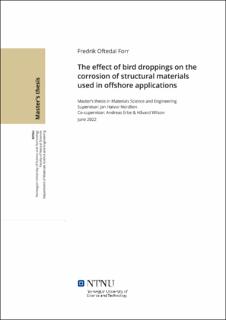| dc.contributor.advisor | Nordlien, Jan Halvor | |
| dc.contributor.advisor | Erbe, Andreas | |
| dc.contributor.advisor | Wilson, Håvard | |
| dc.contributor.author | Forr, Fredrik Oftedal | |
| dc.date.accessioned | 2022-10-13T17:20:11Z | |
| dc.date.available | 2022-10-13T17:20:11Z | |
| dc.date.issued | 2022 | |
| dc.identifier | no.ntnu:inspera:106964958:72028603 | |
| dc.identifier.uri | https://hdl.handle.net/11250/3026010 | |
| dc.description.abstract | Den nåværende trenden i olje- og gassindustrien er at flere aktører ønsker å bygge automatiserte plattformer som er enten normalt ubemannet, eller ubemannet. Dette gir økte krav for design, som må kunne yte for lange perioder uten hverken inspeksjoner eller vedlikehold. Disse plattformene er planlagt å kunne være operative opp til 40 år. Design og materialvalg må være fra øverste hylle, for alle deler av installasjonen for å kunne oppnå dette. I tillegg, vil fravær av personell føre til økt fugleliv på plattformene.
Andre har undersøkt begrensning og avskrekkende virkemidler for fugleliv på plattformer, sammen med kartlegging over hvordan enkelte fugler beveger seg i Nordsjøen. Korrosjonsadferden forårsaket av fugleavføring ble ikke undersøkt. Det er her denne avhandlingen kommer inn da effekten fugleavføring har på korrosjon av stål og aluminium ikke er kjent i litteraturen.
Ved å øke kunnskapen om dette temaet, kan forebyggende tiltak bli utarbeidet for å forlenge levetiden til de ubemannede plattformene. For å gjøre dette har det blitt gjennomført to parallelle tester. Den ene var å utsette utvalgte materialer for et salttåkekammer, med og uten fugleavføring. Dette gir både en visuell presentasjon av hvordan fugleavføringen påvirket korrosjonen, samt et målbart vekttap som sier hvor mye av metallet som har korrodert. Disse prøvene ble så analysert med FTIR og Raman spektroskopi for å lete etter substanser som har festet seg til overflaten av prøvene.
De samme utvalgte materialene ble testet med elektrokjemiske eksperiment. Nærmere bestemt polariserinskurver og polariseringsmotstand. For å kunne gjennomføre elektrokjemiske eksperiment med fugleavføring på overflaten, ble det brukt en ukonvensjonell metode. Denne besto av en sprøyte som inneholdte referanseelektrode og motelektrode sammen med elektrolytten. Fugleavføring kunne da bli ført inn i tuppen på sprøyten. Resultatene fra de elektrokjemiske eksperimentene sto i kontrast mot resultatene fra salttåkekammeret. Dog, verdifull informasjon om korrosjonsadferden ble oppnådd. De elektrokjemiske eksperimentene viste at mange av de testede materialene dro nytte av tilstedeværelsen av fugleavføring. For eksempel passivering, økt pitting-potensial og redusert korrosjonsstrømtetthet ble observert med fugleavføring på overflaten. | |
| dc.description.abstract | The current trend in the oil and gas industry is the desire for building automated platforms that are either "normally unmanned" or "unmanned". This introduces an extreme demand for the design, which must be able to perform for long periods without inspections and maintenance. These platforms are planned to be operational for up to 40 years. The design and material choice must be top-notch for all aspects of the installation to be able to achieve this. In addition, the absence of personnel substantiates more bird life on the platforms.
Others have investigated mitigation and deterrent methods for bird life on platforms, along with mapping of how selected birds move around in the North Sea. The corrosion behaviour due to bird droppings is not studied. This is where this thesis come in, as the bird droppings' effect on corrosion for steels and aluminium is not described in the literature.
By increasing the knowledge of this issue, preventive measures could be made to increase the lifetime of unmanned platforms. To do this there has been conducted two parallel tests. The first was to expose the selected materials to a salt-spray chamber, with and without bird droppings. This has given both a visual presentation of how the bird droppings affect the corrosion of the materials, as well as mass loss measurements that give a measure of the amount of corroded metal. These samples were then analysed using FTIR and Raman spectroscopy to search for traces of substances that had adhered to the surface of the selected materials.
The same selected materials were analyzed using electrochemical experiments. Specifically polarization curves and polarization resistance. To be able to do electrochemical experiments with bird droppings on the surface, an unconventional cell setup was used. This consisted of a syringe that housed the reference and counter electrode along with the electrolyte. Bird droppings could then be put into the tip of the syringe. The electrochemical experiments showed that most materials tested, benefited from the presence of bird droppings, e.g. passivation, increase in pitting potential, and decreased corrosion current density was observed changes. | |
| dc.language | eng | |
| dc.publisher | NTNU | |
| dc.title | The effect of bird droppings on the corrosion of structural materials used in offshore applications | |
| dc.type | Master thesis | |
